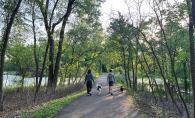
With pet ownership comes spending more time outdoors, which is healthy for owners and their pets. Jean Larson, PhD, at the University of Minnesota says, “When you’re out and about, it’s essential to let dogs follow their instincts while staying on marked paths. While humans are used to moving at their own speed, it’s important to allow dogs to have a say in the pace. “When you are on a walk with your dog, let your dog sniff,” Larson says. “Sniffing on a walk is extremely important for a dog’s wellbeing, and it allows us humans to slow down and enjoy the walk, too.”
Heading out for some exercise and socialization is important for pets. But, let’s face it, they spend a vast majority of their time in their own backyard. Larson gives pet owners a few tips for pet-safe yard care at home. “Invest in a quality fence for your yard,” Larson says. “Physical fencing allows your dog to roam freely and stay safe.” She also says that careful supervision and recognizing your dog’s habits can be a great way to create a space they will enjoy. Is he a digger? Provide a sand pit for digging. Is she a sniffer? Feature areas of heavier cover where your dog can happily sniff. Does your dog like to sunbathe? Find a sunny spot where your dog can warm his belly.
Larson also recommends using dog-safe materials in your landscaping and warns against using cocoa bean mulch and commercial weed killers. Kristi Flynn, DVM and assistant professor at the University of Minnesota College of Veterinary Medicine, says that often, fertilizers with bone meal can also be dangerous. “[They] prove to be irresistible for some dogs and can make a dog sick if they eat too much,” Flynn says.
Shay Lunseth of Edina co-owns Organic Lawns by Lunseth and says their company provides an alternative to chemically based lawncare that is locally sourced and can be better for pets (and kids) and helps establish lawns that are lower maintenance and require less water and nitrogen. She says, “Synthetic fertilizers feed the grass and not the soil and that makes a weak and incomplete system. We feed the soil which feeds the roots and improves the grass … helping the lawn work on its own naturally. Nothing goes to waste or is washed away … It’s a natural fertilizer and is also good for reducing dog spotting because it doesn’t burn out like grass.” There are also no restrictions with Lunseth’s organic fertilizer. Dogs can go on it immediately.
At-home horticulturists should be strategic about what plants are in their gardens, as many can be harmful to cats and dogs if ingested. Yews, castor bean, holly and lilies are a few that can quickly become dangerous. “The best prevention for keeping your dog healthy is to research plants that work in your zone and are safe for your dogs,” Larson says. She suggests books like Dog Friendly Gardens by Cheryl Smith. Pet owners can also visit the American Society for the Prevention of Cruelty to Animals’ online library of poisonous plants.
If you are worried that your pet has eaten something he/she shouldn’t, Flynn recommends contacting a veterinarian or a pet poison center, including the Pet Poison Helpline at 855.764.7661. If you have any questions about your pet’s health, don’t risk it. Contact your veterinarian.









